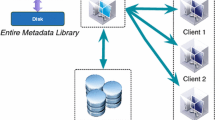Abstract
We present Fatman, an enterprise-scale archival storage based on volunteer contribution resources from under-utilized web servers, usually deployed on thousands of nodes with spare storage capacity. Fatman is specifically designed for enhancing the utilization of existing storage resources and cutting down the hardware purchase cost. Two major concerned issues of the system design are maximizing the resource utilization of volunteer nodes without violating service level objectives (SLOs) and minimizing the cost without reducing the availability of archival system. Fatman has been widely deployed on tens of thousands of server nodes across several datacenters, providing more than 100 PB storage capacity and serving dozens of internal mass-data applications. The system realizes an efficient storage quota consolidation by strong isolation and budget limitation, to maximally support resource contribution without any degradation on host-level SLOs. It novelly improves data reliability by applying disk failure prediction to minish failure recovery cost, named fault-aware data management, dramatically reduces the mean time to repair (MTTR) by 76.3% and decreases file crash ratio by 35% on real-life product workload.
Similar content being viewed by others
References
Sathiamoorthy M, Asteris M, Papailiopoulos D S, Dimakis A G, Vadali R, Chen S, Borthakur D. XORing elephants: Novel erasure codes for big data. In Proc. the 39th VLDB, Aug. 2013, pp.325–336.
Huang C, Simitci H, Xu Y, Ogus A, Calder B, Gopalan P, Li J, Yekhanin S. Erasure coding in windows Azure storage. In Proc. USENIX ATC, Jun. 2012.
Vrable M, Savage S, Voelker G M. Cumulus: Filesystem backup to the cloud. In Proc. the 7th USENIX Conf. File and Storage Technologies, Feb. 2009, pp.225–238.
Vrable M, Savage S, Voelker G M. BlueSky: A cloud-backed file system for the enterprise. In Proc. the 10th USENIX Conf. File and Storage Technologies, Feb. 2012, pp.19:1–19:14.
Reed I S, Solomon G. Polynomial codes over certain finite fields. Journal of the Society for Industrial and Applied Mathematics, 1960, 8(2): 300–304.
Khan O, Burns A, Plank J, Pierce W, Huang C. Rethinking erasure codes for cloud file systems: Minimizing I/O for recovery and degraded reads. In Proc. the 10th USENIX Conf. File and Storage Technologies, Feb. 2012, pp.20:1–20:14.
Cipar J, Corner M D, Berger E D. TFS: A transparent file system for contributory storage. In Proc. the 5th USENIX Conf. File and Storage Technologies, Feb. 2007, pp.215–229.
McKusick M K, Joy W N, Leffler S J, Fabry R S. A fast file system for UNIX. ACM Trans. Comput. Syst., 1984, 2(3): 181–197.
Hoelzle U, Barroso L A. The Datacenter as a Computer: An Introduction to the Design of Warehouse-Scale Machines (1st edition). Morgan and Claypool Publishers, 2009.
Schroeder B, Gibson G A. Disk failures in the real world: What does an MTTF of 1,000,000 hours mean to you? In Proc. the 5th USENIX Conf. File and Storage Technologies, Feb. 2007, pp.1:1–1:16.
Barham P, Dragovic B, Fraser K, Hand S, Harris T L, Ho A, Neugebauer R, Pratt I, Warfield A. Xen and the art of virtualization. In Proc. the 19th SOSP, Oct. 2003, pp.164–177.
Soltesz S, P¨otzl H, Fiuczynski M E, Bavier A C, Peterson L L. Container-based operating system virtualization: A scalable, high-performance alternative to hypervisors. In Proc. the 2nd EuroSys, Mar. 2007, pp.275–287.
Ghemawat S, Gobioff H, Leung S T. The Google file system. In Proc. the 19th SOSP, Oct. 2003, pp.29–43.
Jiang W, Hu C, Zhou Y, Kanevsky A. Are disks the dominant contributor for storage failures? A comprehensive study of storage subsystem failure characteristics. In Proc. the 6th USENIX Conf. File and Storage Technologies, Feb. 2008, pp.111–125.
Xin Q, Schwarz T J E, Miller E L. Disk infant mortality in large storage systems. In Proc. the 13th MASCOTS, Sept. 2005, pp.125–134.
Rodrigues R, Liskov B. High availability in DHTS: Erasure coding vs. replication. In Proc. the 4th IPTPS, Feb. 2005, pp.226–239.
Tamo I, Papailiopoulos D S, Dimakis A G. Optimal locally repairable codes and connections to matroid theory. In Proc. CoRR, Jan. 2013.
Vishwanath K V, Nagappan N. Characterizing cloud computing hardware reliability. In Proc. the 1st SoCC, Jun. 2010, pp.193–204.
Zhu B, Wang G, Liu X, Hu D, Lin S, Ma J. Proactive drive failure prediction for large scale storage systems. In Proc. the 29th MSST, Jun. 2013.
Paris J, Schwarz T J E, Long D. Evaluating the reliability of storage systems. Technical Report, UH-CS-06-08, Department of Computer Science, University of Houston, 2006.
Larson S M, Snow C D, Shirts M, Pande V S. Folding@home and Genome@home: Using distributed computing to tackle previously intractable problems in computational biology. arXiv: 0901.0866, 2009. http://arxiv.org/abs/0901.0866, Jan. 2015.
Durrani M N, Shamsi J A. Volunteer computing: Requirements, challenges, and solutions. J. Network and Computer Applications, 2014, 39: 369–380.
Hamerly G, Elkan C. Bayesian approaches to failure prediction for disk drives. In Proc. the 18th ICML, Jun. 2001, pp.202–209.
Hughes G F, Murray J F, Kreutz-Delgado K, Elkan C. Improved disk-drive failure warnings. IEEE Transactions on Reliability, 2002, 51(3): 350–357.
Murray J F, Hughes G F, Kreutz-Delgado K. Machine learning methods for predicting failures in hard drives: A multiple-instance application. Journal of Machine Learning Research, 2005, 6: 783–816.
Bitton D, Gray J. Disk shadowing. In Proc. the 14th VLDB, Aug. 1988, pp.331–338.
Chen P M, Lee E L, Gibson G A, Katz R H, Patterson D A. RAID: High-performance, reliable secondary storage. ACM Comput. Surv., 1994, 26(2): 145–185.
Plank J S. A tutorial on Reed-Solomon coding for faulttolerance in RAID-like systems. Software — Practice & Experience, 1997, 27(9): 995–1012.
Qin A, Hu D, Liu J, Yang W, Tan D. Fatman: Cost-saving and reliable archival storage based on volunteer resources. In Proc. the 40th VLDB, Sept. 2014, pp.1748–1753.
Author information
Authors and Affiliations
Corresponding author
Rights and permissions
About this article
Cite this article
Qin, A., Hu, DM., Liu, J. et al. Fatman: Building Reliable Archival Storage Based on Low-Cost Volunteer Resources. J. Comput. Sci. Technol. 30, 273–282 (2015). https://doi.org/10.1007/s11390-015-1521-6
Received:
Revised:
Published:
Issue Date:
DOI: https://doi.org/10.1007/s11390-015-1521-6




